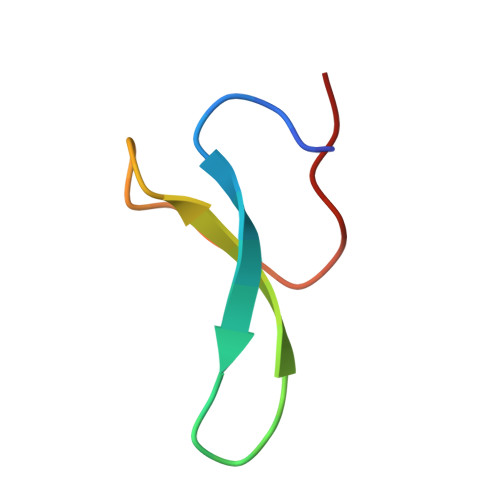The Dependence of Carbohydrate-Aromatic Interaction Strengths on the Structure of the Carbohydrate.
Hsu, C.H., Park, S., Mortenson, D.E., Foley, B.L., Wang, X., Woods, R.J., Case, D.A., Powers, E.T., Wong, C.H., Dyson, H.J., Kelly, J.W.(2016) J Am Chem Soc 138: 7636-7648
- PubMed: 27249581
- DOI: https://doi.org/10.1021/jacs.6b02879
- Primary Citation of Related Structures:
2NC3, 2NC4, 2NC5, 2NC6 - PubMed Abstract:
Interactions between proteins and carbohydrates are ubiquitous in biology. Therefore, understanding the factors that determine their affinity and selectivity are correspondingly important. Herein, we have determined the relative strengths of intramolecular interactions between a series of monosaccharides and an aromatic ring close to the glycosylation site in an N-glycoprotein host. We employed the enhanced aromatic sequon, a structural motif found in the reverse turns of some N-glycoproteins, to facilitate face-to-face monosaccharide-aromatic interactions. A protein host was used because the dependence of the folding energetics on the identity of the monosaccharide can be accurately measured to assess the strength of the carbohydrate-aromatic interaction. Our data demonstrate that the carbohydrate-aromatic interaction strengths are moderately affected by changes in the stereochemistry and identity of the substituents on the pyranose rings of the sugars. Galactose seems to make the weakest and allose the strongest sugar-aromatic interactions, with glucose, N-acetylglucosamine (GlcNAc) and mannose in between. The NMR solution structures of several of the monosaccharide-containing N-glycoproteins were solved to further understand the origins of the similarities and differences between the monosaccharide-aromatic interaction energies. Peracetylation of the monosaccharides substantially increases the strength of the sugar-aromatic interaction in the context of our N-glycoprotein host. Finally, we discuss our results in light of recent literature regarding the contribution of electrostatics to CH-π interactions and speculate on what our observations imply about the absolute conservation of GlcNAc as the monosaccharide through which N-linked glycans are attached to glycoproteins in eukaryotes.
Organizational Affiliation:
Department of Molecular and Experimental Medicine, The Scripps Research Institute , La Jolla, California 92037, United States.















